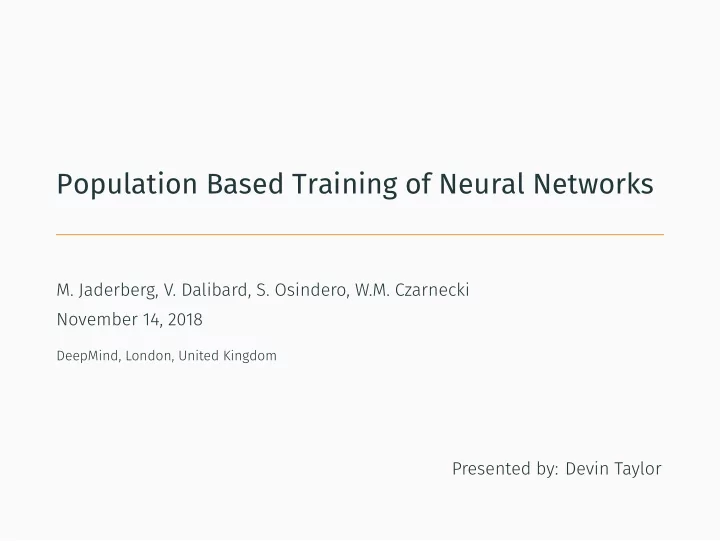

Presented by: Devin Taylor Population Based Training of Neural Networks M. Jaderberg, V. Dalibard, S. Osindero, W.M. Czarnecki November 14, 2018 DeepMind, London, United Kingdom
Problem Statement Problem statement Neural networks suffer from sensitivity to empirical choices of hyperparameters Solution Asynchronous optimisation algorithm that jointly optimises a population of models 1
Key Idea Figure 1: Overview of proposed approach 2
Population Based Training - Algorithm • step - weight update • eval - performance evaluation • ready - current path limit • exploit - compare to population • explore - adjust hyperparameters Figure 2: PBT algorithm 3
Population Base Training - Core • exploit • Replace weights and/or hyperparameters • T-test selection, truncation selection, binary tournament • explore • Adjust hyperparameters • Perturb, resample Figure 3: PBT dummy example 4
Implementation Notes • Asynchronous • No centralised orchestrator • Only current performance information, weights, hyperparameters published • No synchronisation of population 5
Experiments Experiments conducted in three areas: • Deep reinforcement learning - Find policy to maximise expected episodic return • Neural machine translation - Convert sequence of words from one language to another • Generative adversarial networks - Generative models with competing components, generator and descriminator 6
Results - Spoiler Figure 4: PBT result summary 7
Results - Deep reinforcement learning Figure 5: PBT deep reinforcement learning result - DM Lab 8
Results - Machine translation Figure 6: PBT machine translation results 9
Results - Generative Adversarial Networks Figure 7: PBT GAN results 10
Analysis Figure 8: PBT design space analysis 11
Analysis Figure 9: PBT lineage analysis 12
Analysis Figure 10: PBT development as phylogenetic tree 13
Critique • No results showing evidence quite large requirements (10 workers) • Minimum computational • Is susceptible to local minima steps, perturb, etc) hyperparameters ( ready • Added in additional of reduced time Negatives Positives • Improved training stability for hyperparameter tuning • Approximate complex paths sacrificing on time • Result improvements without unanswered some questions left • Detailed analysis - although • Well written 14
Related Work • Unique genetic algorithm approach to implementation - parallel and sequential • Author: Max Jaderberg • Mix&Match: Agent Curricula for Reinforcement Learning - boostrapping off simpler agents 15
Conclusion • Presented algorithm that asynchronously and jointly optimises a population of models • Obtained improved results on a range of different algorithms • Still certain questions unanswered but still a good contribution 16
Recommend
More recommend